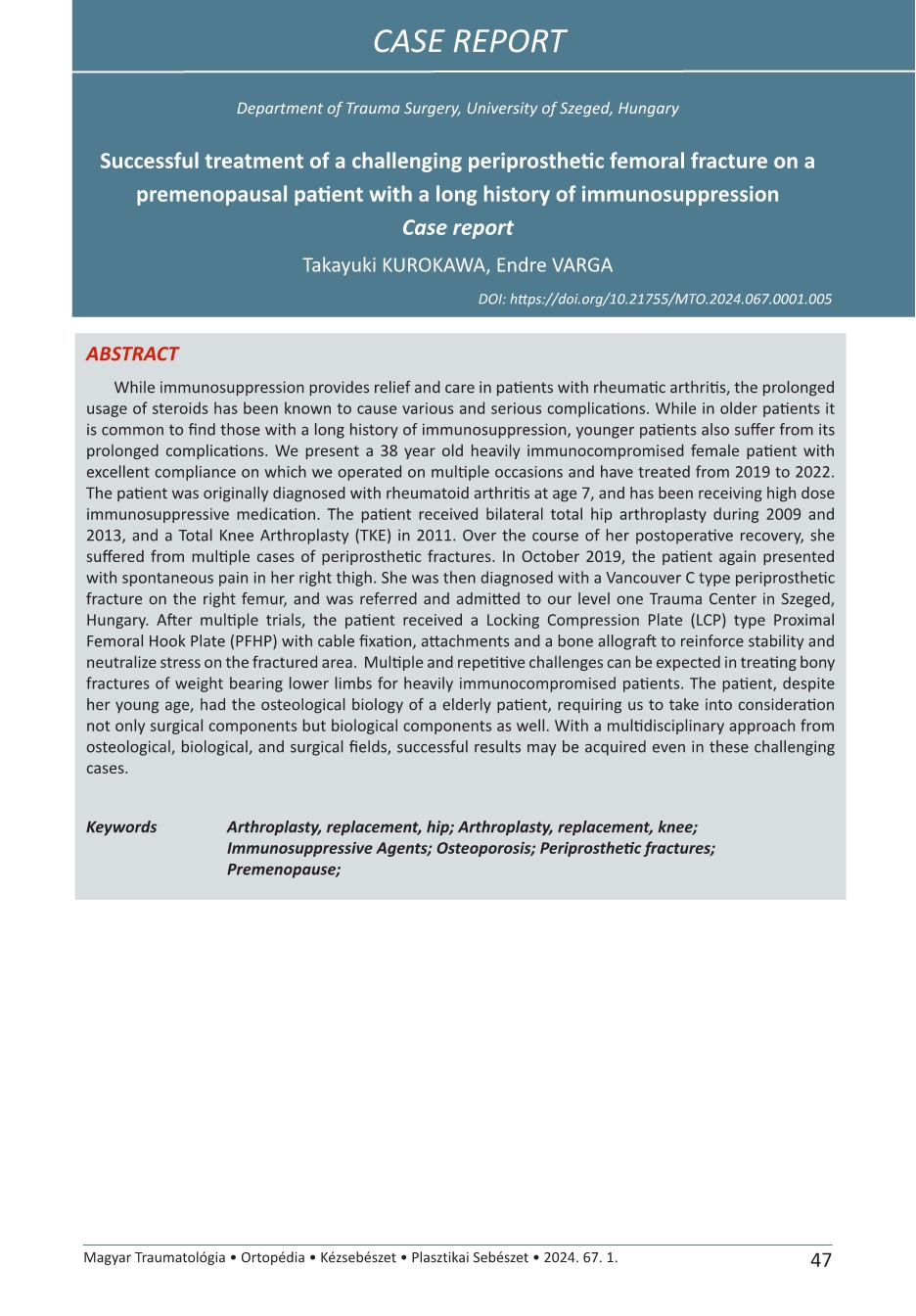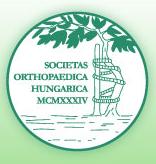Successful treatment of a challenging periprosthetic femoral fracture on a premenopausal patient with a long history of immunosuppression
Case report
Absztrakt
While immunosuppression provides relief and care in patients with rheumatic arthritis, the prolonged usage of steroids has been known to cause various and serious complications. While in older patients it is common to find those with a long history of immunosuppression, younger patients also suffer from its prolonged complications. We present a 38 year old heavily immunocompromised female patient with excellent compliance on which we operated on multiple occasions and have treated from 2019 to 2022. The patient was originally diagnosed with rheumatoid arthritis at age 7, and has been receiving high dose immunosuppressive medication. The patient received bilateral total hip arthroplasty during 2009 and 2013, and a Total Knee Arthroplasty (TKE) in 2011. Over the course of her postoperative recovery, she suffered from multiple cases of periprosthetic fractures. In October 2019, the patient again presented with spontaneous pain in her right thigh. She was then diagnosed with a Vancouver C type periprosthetic fracture on the right femur, and was referred and admitted to our level one Trauma Center in Szeged, Hungary. After multiple trials, the patient received a Locking Compression Plate (LCP) type Proximal Femoral Hook Plate (PFHP) with cable fixation, attachments and a bone allograft to reinforce stability and neutralize stress on the fractured area. Multiple and repetitive challenges can be expected in treating bony fractures of weight bearing lower limbs for heavily immunocompromised patients. The patient, despite her young age, had the osteological biology of a elderly patient, requiring us to take into consideration not only surgical components but biological components as well. With a multidisciplinary approach from osteological, biological, and surgical fields, successful results may be acquired even in these challenging cases.
Hivatkozások
Bermas BL, Hill JA. Effects of immunosuppressive drugs during pregnancy. Arthritis Rheum. 1995. 38(12): 1722-1732. https://doi.org/10.1002/art.1780381203
Civitelli R, Ziambaras K. Epidemiology of glucocorticoid-induced osteoporosis. J Endocrinol Invest. 2008. 31(7 Suppl): 2-6.
Glerup M, Rypdal V, Arnstad ED, Ekelund M, Peltoniemi S, Aalto K; Nordic Study Group of Pediatric Rheumatology. Long-term outcomes in juvenile idiopathic arthritis: eighteen years of follow-up in the Population-Based Nordic Juvenile Idiopathic Arthritis Cohort. Arthritis Care Res (Hoboken). 2020. 72(4): 507-516. https://doi.org/10.1002/acr.23853
Keenan OJF, Ross LA, Magill M, Moran M, Scott CEH. Immediate weight-bearing is safe following lateral locked plate fixation of periprosthetic distal femoral fractures. Knee Surg Relat Res. 2021. 33(1): 19. https://doi.org/10.1186/s43019-021-00097-0
Lane NE, Sanchez S, Modin GW, Genant HK, Pierini E, Arnaud CD. Bone mass continues to increase at the hip after parathyroid hormone treatment is discontinued in glucocorticoid-induced osteoporosis: results of a randomized controlled clinical trial. J Bone Miner Res. 2000. 15(5): 944-951. https://doi.org/10.1359/jbmr.2000.15.5.944
Lv H, Guo X, Wang YH, Zhang ZJ, Zou LF, Xue H, Huang DH, Tan MY. Open reduction and locked compression plate fixation, with or without allograft strut, for periprosthetic fractures in patients who had a well-fixed femoral stem: a retrospective study with an average 2-year follow-up. BMC Musculoskelet Disord. 2022. 23(1): 69. https://doi.org/10.1186/s12891-022-05008-2
Marks R. Impact of obesity on complications following primary hip joint arthroplasty surgery for osteoarthritis marks. J Arthritis. 2015. S1: 003. https://doi.org/10.4172/2167-7921.S1-003
McLendon AN, Woodis CB. A review of osteoporosis management in younger premenopausal women. Womens Health. 2014. 10(1): 59-77. https://doi.org/10.2217/WHE.13.73
Paulsson M, Ekholm C, Jonsson E, Geijer M, Rolfson O. Immediate full weight-bearing versus partial weight-bearing after plate fixation of distal femur fractures in elderly patients. A randomized controlled trial. Geriatr Orthop Surg Rehabil. 2021. 12: 21514593211055889. https://doi.org/10.1177/21514593211055889
Rasouli MR, Porat MD, Hozack WJ, Parvizi J. Proximal femoral replacement and allograft prosthesis composite in the treatment of periprosthetic fractures with significant proximal bone loss. Orthop Surg. 2012. 4(4): 203-210. https://doi.org/10.1111/os.12000
Smith WR, Stoneback JW, Morgan SJ, Stahel PF. Is immediate weight bearing safe for periprosthetic distal femur fractures treated by locked plating? A feasibility study in 52 consecutive patients. Patient Saf Surg. 2016. 10: 26. https://doi.org/10.1186/s13037-016-0114-9
Striano BM, Grisdela PT Jr, Shapira S, Heng M. Early weight bearing after distal femur fracture fixation. Geriatr Orthop Surg Rehabil. 2022. 13: 21514593211070128. https://doi.org/10.1177/21514593211070128
Sunyecz JA. The use of calcium and vitamin D in the management of osteoporosis. Ther Clin Risk Manag. 2008. 4(4): 827-836. https://doi.org/10.2147/TCRM.S3552
Wang W, Yeung KWK. Bone grafts and biomaterials substitutes for bone defect repair: A review. Bioact Mater. 2017. 2(4): 224-247. https://doi.org/10.1016/j.bioactmat.2017.05.007
Whitfield JF. The bone growth-stimulating PTH and osteosarcoma. Medscape Womens Health. 2001. 6(5): 7.
Zhang B, Hu ST, Zhang YZ. Spontaneous rupture of multiple extensor tendons following repeated steroid injections: a case report. Orthop Surg. 2012. 4(2): 118-121. https://doi.org/10.1111/j.1757-7861.2012.00170.x











